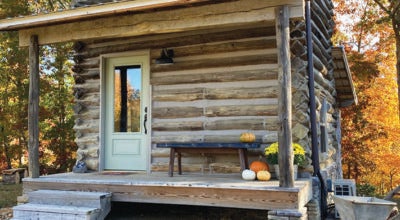Shallowford: From important historical river crossing to a new park
Published 9:10 am Thursday, March 25, 2021
|
Getting your Trinity Audio player ready...
|
By Marcia Phillips
For the Enterprise
Shallowford has been in the news lately as Forsyth County has launched a multi-million dollar project to turn 246 acres on the east side of the Yadkin River into a historic preservation site with walkways and canoeing.
It is by no means the first time this spot has made news and while the land is in Forsyth, the story is also ours in Davie County.
The Shallow Ford (as it was known in earlier history) was more than a road or a spot on the Yadkin River.
For hundreds of years, native Americans had canoed down it. Then, like the Grand Central Station of the Piedmont for the 18th and 19th centuries, it was a major intersection that saw settlers move in and military action in both the Revolutionary and Civil Wars.
Located just outside Davie County near Huntsville over the line into Yadkin County now, it brought multitudes into and across our acres.
Before there were modern means of transportation or even good roads, in the Colonial era rivers were a means of transport but also an obstacle to be crossed. A ford in a river provided a place to walk, ride or drive wagons safely across an otherwise dangerous current. The Yadkin River (often described as temperamental) had several such fords, most notably the Trading Ford in Salisbury, but none saw more action than the Shallow Ford.
To be safe, a ford across a river had to be more than just a place of shallow water. After all, rainy seasons (think recently) alters that dramatically. Shallow Ford also provided a stable base for horses’ hoofs or wagon wheels.
The Shallow Ford was and still is a gravel and sand formation that is relatively flat and extends underwater from one side of the river to the other, in this case about 100 yards. It not only gives solid stone to cross on rather than slippery mud but it makes it more like wading than swimming; some older photographs made it appear as if men were walking on water. But it was not always safe if flooding caused high water levels.
At the ford, there was a boulder known as the ford rock. If it was not visible above water, then it was too deep to cross without the threat of being swept away. Generally, any time the water was 3 feet high over the path, it was considered unsafe but one foot depth was ideal. Some droughts have made the path visible.
The Great Wagon Road that brought settlers from Pennsylvania crossed at Shallow Ford, making it a landmark on early migration maps. While many settlers continued as far as Georgia, others such as Morgan Bryan and Squire Boone stopped after this crossing and stayed in this portion of Rowan County, now Davie.
Naturally high roads were packed down by wagon trains but had to descend, as you still must do today on either side, to cross as the lower Yadkin River slices through the landscape. Campgrounds (that existed into the early 20th century) on each side sprung up as travelers waited for their turn or for the river to go down.
All major roads in the area led to Shallow Ford as a narrow gateway to the other side.
A few years later, those settlers were fighting for independence from British control. Tories and Patriots first clashed in a skirmish at a place still called Battle Branch in 1780.
A year later, when Patriot Nathaniel Greene raced General Cornwallis across the Carolinas, Greene crossed at the Trading Ford before the water rose too high and commandeered all the boats in the area. Cornwallis had to aim for the Shallow Ford and traipsed across present day Davie County to get there. Legend says the muddy terrain to the west of Dutchman’s Creek near present day Farmington Road was so thick he famously said it was like treading through pudding (a British dessert term that implies more dense texture than we think of as pudding); hence the name Pudding Ridge stuck. He encountered freedom fighters near the ford and all these local elements – the sticky mud, the stubborn men – slowed him down to where Greene was ready to face him with reinforcements at the Battle of Guilford Courthouse. The British won that battle but with such huge losses that they soon lost the war and a few months later, Cornwallis surrendered to George Washington at Yorktown. It was a turning point in the War for Independence in the South and our identity as Americans was secured at a river bank.
Things did not turn out as well for local resistance in the Civil War. U.S. General George Stoneman was leading troops on a destructive path similar to Sherman’s across the Carolinas. Coming from the opposite direction as Cornwallis had, he left Salem devastated and headed towards Salisbury and its prisoner-of-war camp, burning bridges along the way.
But you cannot burn water.
While crossing the Shallow Ford, he surprised some home guard rebels who were determined but greatly outnumbered and could not stop or protect the homes behind them. Some farmers cooperated and fed the Union troops, others were harassed and many were robbed.
My great-grandmother Jane Stonestreet Boger told me accounts of how her mother Martha muzzled the family horses in the woods along Cana Road to prevent their loss. Stoneman had crossed the river before daylight, ravaged every place in his path (although spared torching the town of Mocksville) and moved on within the day. It was April 11, 1865; Lee had surrendered at Appomattox Court House two days before. The war was already lost and it had been determined we would remain Americans.
The Shallow Ford continued to be a major thoroughfare for another 50 plus years along with many ferries that also provided crossings of the Yadkin; the most well-known to Davie was the Hall family one for 90 years near the current I-40 bridge at Clemmons.
Ferries were also risky and had to use cables strung across the Yadkin to prevent being carried downstream. By 1920 ferries and fords were obsolete as bridges had been built on Highways 158 and 421 and at Shallow Ford where the West Bend Bridge stands about 600 yards north of the old ford. The advent of automobiles had triggered the need for bridges. Ironically Model Ts with the name FORD emblazoned on the front grill now “forded” the river.
Shallow Ford witnessed history, often violent, and has receded into an era where it will be a peaceful setting for recreation. There are plans for canoe rentals so once again families will travel down the river as well as cross it.





